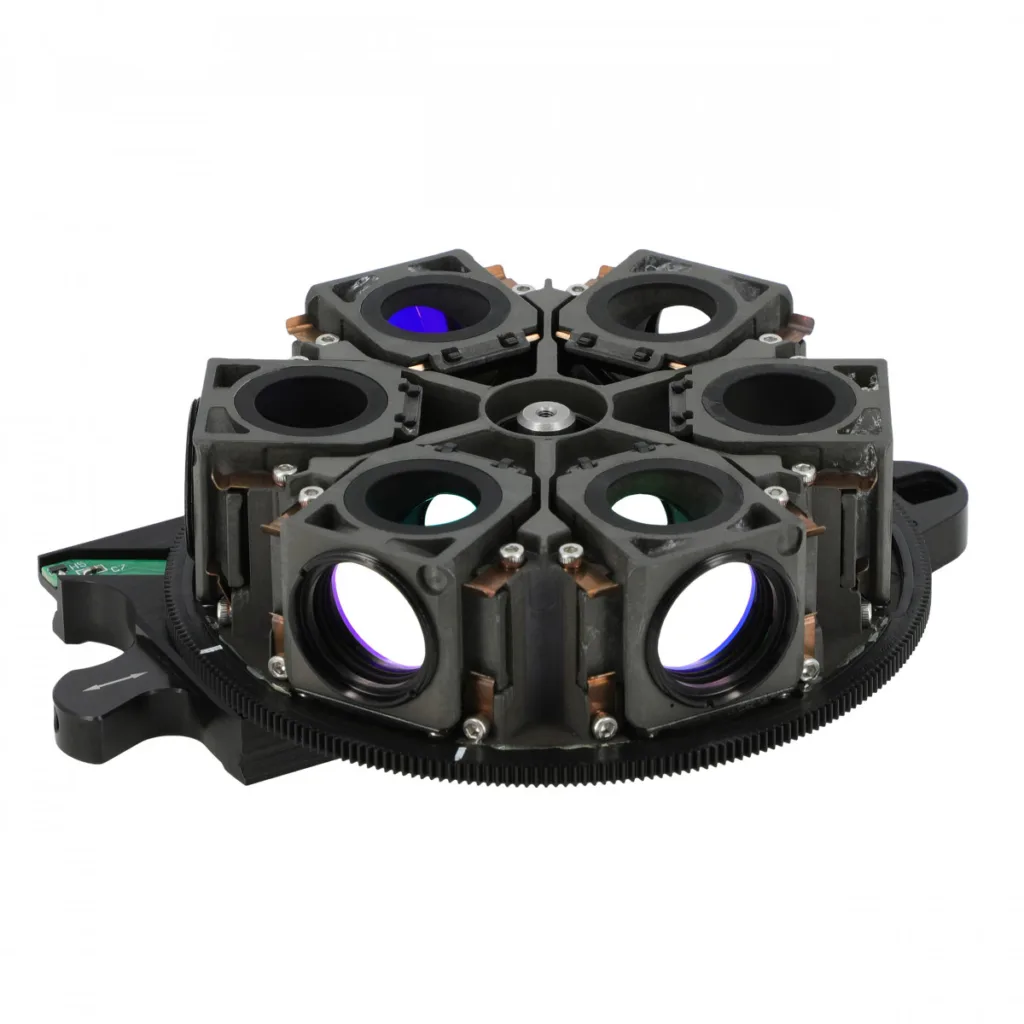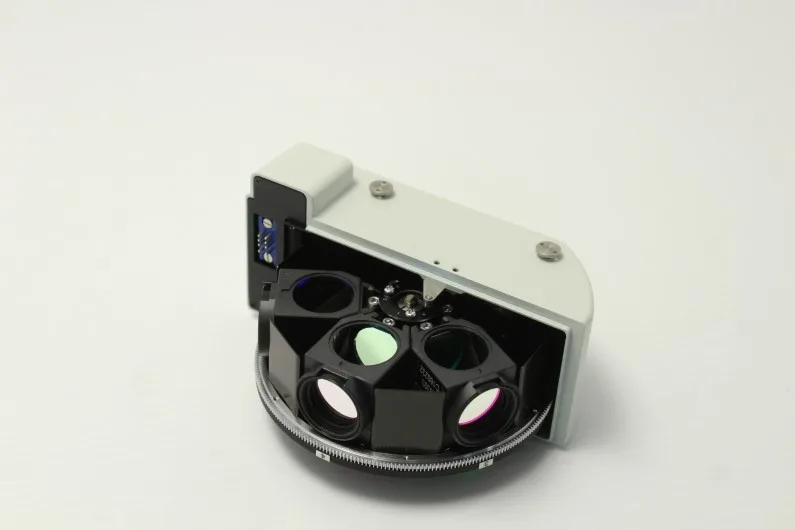Introduction
A fluorescence filter cube turret is an essential component in fluorescence microscopy, playing a pivotal role in enabling scientists to observe and study fluorescent specimens. It is a practical and user-friendly device that simplifies the process of selecting and switching between various filter sets, ultimately enhancing the quality of fluorescence imaging.
What is a Fluorescence Filter Cube Turret?
At its core, a fluorescence filter cube turret is a rotating wheel-like mechanism, often situated within the microscope’s optical path. Its primary function is to hold and facilitate the quick interchange of filter sets, each consisting of a combination of specific optical components, such as excitation and emission filters, dichroic mirrors, and other optical elements.

How Does a Fluorescence Filter Cube Turret Work?
Filter Sets:
The turret typically accommodates three to four filter sets, each designed to work with specific fluorescent dyes or markers. These filter sets are crucial for controlling the excitation and emission of light during microscopy.
Filter Selection:
To use a particular filter set, researchers rotate the turret manually or electronically. This action aligns the chosen filter set with the optical path of the microscope, allowing the excitation light and emitted fluorescence to pass through it.
Excitation Light Control:
Within each filter set, excitation filters are responsible for selectively allowing specific wavelengths of light to illuminate the specimen. This ensures that only the desired excitation light reaches the sample.
Dichroic Mirror:
A dichroic mirror, another key component within the filter set, reflects the excitation light towards the specimen while allowing the emitted fluorescence to pass through.
Emission Filters:
Once the excitation light interacts with the specimen, it triggers the emission of fluorescent light. This emitted fluorescence must pass through an emission filter, also present in the selected filter set. The emission filter ensures that only the fluorescent light of interest is transmitted to the detector or camera, effectively blocking unwanted background light.
Filter Efficiency:
The fluorescence filter cube turret’s rapid filter-swapping capabilities empower scientists to swiftly switch between different fluorescent markers during their experiments. This versatility is invaluable in obtaining precise and detailed fluorescence images without the need for time-consuming adjustments or disassembly of the microscope.
Enhanced Imaging:
By seamlessly coordinating the excitation and emission light paths, the fluorescence filter cube turret enhances the quality of fluorescence imaging. This enables researchers to capture accurate data and produce high-quality images, facilitating a better understanding of the specimen under study.
Different types of fluorescent filter
Fluorescent filters come in various types, each serving a specific purpose in fluorescence microscopy:
Excitation Filters: These filters allow specific wavelengths of excitation light to reach the specimen, ensuring precise targeting of fluorescent markers.
Emission Filters: Emission filters are crucial for isolating and detecting the emitted fluorescent light while blocking unwanted background illumination.
Dichroic Mirrors (Beamsplitters): Dichroic mirrors are used to separate excitation and emission light by reflecting the former towards the specimen and transmitting the latter towards the detector.
Longpass and Shortpass Filters: Longpass filters transmit light with longer wavelengths, while shortpass filters allow shorter wavelengths to pass through. They are used for spectral filtering.
Bandpass Filters: These filters permit a specific range of wavelengths to pass through, ideal for isolating narrow spectral lines and reducing background noise.
Neutral Density Filters: Neutral density filters attenuate the intensity of both excitation and emission light, helpful for reducing photobleaching and phototoxicity.
Multi-band Filters: These advanced filters are designed to transmit multiple wavelength ranges, allowing simultaneous imaging of multiple fluorescent markers.
Variable Filters: Some filters have adjustable properties, such as variable bandwidth or attenuation, offering flexibility in experimental setups.
The purpose of the fluorescent filter cube turret
The fluorescent filter cube turret serves a vital purpose in fluorescence microscopy, making the imaging process efficient and versatile. Here’s why it’s such a valuable tool:
Filter Swapping: One of its primary roles is to allow researchers to quickly switch between different filter sets. This feature is crucial for studying various fluorescent markers within the same experiment without disassembling the microscope.
Wavelength Control: The turret enables precise control over the wavelengths of light used for excitation and emission. By selecting the appropriate filter set, scientists can target specific fluorescent dyes or markers with precision.
Minimizing Background Noise: By swiftly changing filters, the turret helps reduce background noise and unwanted light during fluorescence imaging. This enhances the quality and clarity of the acquired images.
Optimizing Experiments: Researchers can fine-tune their experiments by selecting filter sets that match the spectral characteristics of their fluorescent probes. This optimization ensures accurate and reliable results.
Efficiency: The turret’s efficiency in filter switching saves time and simplifies the imaging process, allowing scientists to focus on their research rather than cumbersome adjustments.
Versatility: Its ability to hold multiple filter sets increases the versatility of the microscope. Scientists can explore a wide range of fluorescent markers and tailor their experiments to their specific needs.
Reduced Photobleaching: Quick filter changes help reduce photobleaching, a phenomenon where fluorescent molecules lose their brightness over time due to excessive exposure to light. This prolongs the lifespan of the fluorescent samples.
Enhanced Imaging: By streamlining the excitation and emission light paths, the turret ensures that only the desired fluorescent signals are captured, resulting in high-quality images and more accurate data.
User-Friendly: The turret’s design is user-friendly, making it accessible even to those new to fluorescence microscopy. It simplifies the microscope setup and operation.

FAQs
What is a fluorescent filter cube turret exactly?
A fluorescent filter cube turret is a device used in microscopy to hold and switch between different filter sets for fluorescence imaging.
Why is a fluorescent filter cube turret important?
It’s crucial for selecting specific wavelengths of light and reducing background noise, leading to high-quality fluorescence images.
How many filter sets can a turret typically hold?
Fluorescent filter cube turrets can usually hold three to four filter sets, offering versatility in experiments.
Can I use a turret to study multiple fluorescent markers in one sample?
Yes, you can easily switch between filter sets, allowing simultaneous observation of multiple fluorescent markers within a single experiment.
Does using a turret reduce photobleaching in fluorescence samples?
Yes, the rapid filter switching minimizes photobleaching, preserving the brightness and longevity of fluorescent samples.
